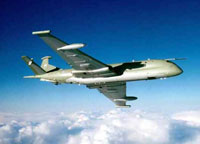Fuel leak caused British Nimrod plane crash in Afghanistan last year
Fuel leak is the most probable reason for a fire that destroyed a British Nimrod aircraft in Afghanistan last year, killing 14 people.

Defense Secretary Des Browne, who presented the findings to the House of Commons, said steps have been taken to ensure that a similar accident cannot occur again. He added there is no reason to ground Britain's aging fleet of Nimrods, which has been kept in service for longer than planned and criticized by some as unsafe.
The Nimrod MR2 crashed 20 kilometers (12 miles west) of Kandahar, Afghanistan, on Sept. 2, 2006, while carrying out an intelligence-gathering mission, killing 12 crew. A Royal Marine and an army soldier also died.
"The Board of Inquiry established the most probable cause of the fire and subsequent loss of Nimrod XV230 and in doing so, identified failings for which the Ministry of Defense must take responsibility," Browne said in a speech to lawmakers.
The crash was the highest death toll in a single tragedy involving British forces since the 1982 Falklands War.
"On behalf of the (Defense Ministry) and the Royal Air Force, I would like apologize to the House of Commons, and most of all to those who lost their lives and to their families. I am sorry," Browne said.
Browne told parliament that incomplete evidence because of the destruction of the Nimrod near Kandahar and fighting with Taliban that was occurring in the area at the time meant investigators were unable to identify with certainty the cause of the fire on the Nimrod.
"The fire most likely resulted from escaped fuel igniting against a hot pipe in a compartment" near a wing of the aircraft," Air Chief Marshal Sir Glenn Torpy said. "Action has been taken to prevent the reoccurrence of this accident and I would like to reassure our service personnel and the public that this aircraft is still safe to fly."
The plane was part of a fleet of 15 aging Nimrod MR2 reconnaissance aircraft that originally had been due to leave service a decade ago. The Nimrod MR1 first entered service with the RAF in 1969, and was upgraded to the MR2 version in the late 1970s.
But a series of lengthy delays to their planned replacement the Nimrod MR4A means that they will have to continue flying until about 2011.
Critics have blamed cost-cutting by the Treasury and the Defense Ministry for the delay.
Prime Minister Gordon Brown's government has faced criticism over its alleged lack of support for Britain's armed forces. Last month, five former chiefs of defense condemned Brown in a House of Lords debate, accusing him of failing to provide adequate funding for the military.
Subscribe to Pravda.Ru Telegram channel, Facebook, RSS!


